The quest for net zero steel
21 March 2022
Zero carbon steel may not be commercially available yet - but that hasn’t stopped some of the world’s biggest construction companies from demanding it. Lucy Barnard meets the head of SteelZero, Mike Peirce to find out more.
Mike Peirce, the head of SteelZero, the group campaigning for zero-carbon steel, runs down a list of construction and property big hitters among his membership; Eiffage, LandSec, Mace, Multiplex, WSP…
“We’ve brought these companies together because construction and property really matter for steel procurement,” he says, still running his pencil down the list.
Accounting for about 7% of global emissions, the steel industry is one of the world’s biggest emitters of carbon dioxide and is already under intense pressure to reduce carbon emissions. And the construction sector is one of the largest users of steel.
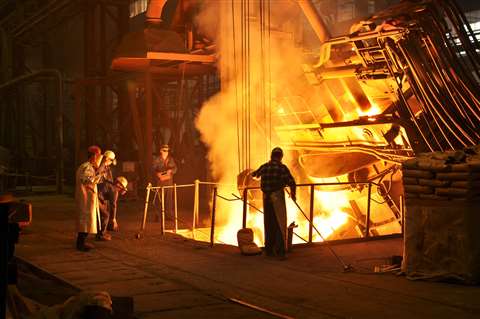 Inside a steel mill. Photo: Adobe Stock
Inside a steel mill. Photo: Adobe Stock
“If you’re looking for one of the biggest producers of carbon dioxide in the world, it’s the steel industry,” says Peirce, who is corporate partnership director UK-based non-government organisation, The Climate Group. “And then you say OK, let’s look at the biggest sector producing demand for that, it’s building and construction. 51% of steel used globally is used for construction and infrastructure. That is why we’ve got to get movement on this.”
Together Peirce estimates that SteelZero’s 18 members procure and specify a total of almost two mega tonnes of crude steel annually – roughly the same as the entire annual output of an industrial sized steel mill.
Although most of the members comprise contractors, property developers and engineers, the group also includes steel suppliers, renewable energy companies and architects.
The thing they all have in common is that each and every one of them has made a public commitment to buy, specify or stock only zero-carbon steel from the year 2050 and, in the meantime to purchase, specify or stock “lower carbon” steel to make up half of the steel they use by 2030.
Demand for net zero steel
“This is a group of companies who have already looked at operations emissions and renewables. They have got advanced sustainability commitments and are therefore looking for the next big issue to tackle. And we know this is also where the steel production is moving,” he says.
“It’s a very simple point – here we are. We would like to buy this. We’re showing forward commitment of demand so that suppliers can say OK, this is another bit of evidence to inform their investment decision making.”
The only problem is that, as Peirce readily admits, at the moment, it is impossible for firms to get hold of zero-carbon steel at any meaningful scale because of the long investment cycles in the steel industry. And that, in short is the point of the group.
“Currently there is no net-zero steel available to buy, certainly not on the scale needed by any of the large construction companies which make up a large part of the group’s membership,” Peirce says. “A lot of significant investment is needed to be able to decarbonise the steel making process before any of the companies that have joined us are able to buy net zero steel at a competitive price. What we’ve done is to create that forward signal to the suppliers to say, this is what people want. How can you move forward on some of the big investment cycles that you need to, to be able to supply that?”
Last year Swedish steelmaker SSAB announced it had produced fossil-free steel for the Volvo Group as part of a pilot project set up through its Hydrogen Breakthrough Ironmaking Technology (HYBRIT) partnership with state iron-ore producer LKAB and state power company Vattenfall.
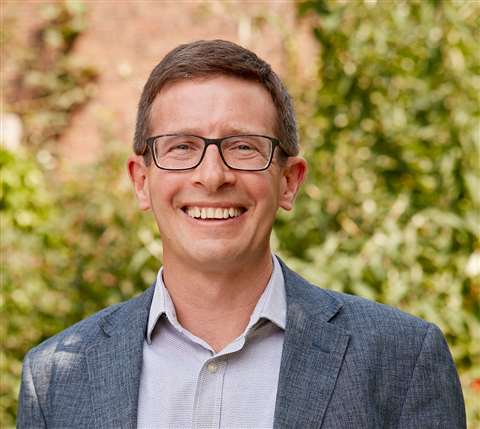 Mike Peirce, director of corporate partnerships at The Climate Group, leads SteelZero. Photo: SteelZero
Mike Peirce, director of corporate partnerships at The Climate Group, leads SteelZero. Photo: SteelZero
Instead of using a blast furnace to add carbon to iron ore in the first part of the steelmaking process, SSAB’s HYBRIT technique entails using green hydrogen to produce sponge iron, before converting it to steel using an electric arc furnace (see box). SSAB said it plans to scale up its operations to produce 1.35 million tonnes of sponge iron a year by 2026.
And SSAB is not alone. Most of the major steel producers in the Western world have announced plans to cut carbon emissions.
In July 2021, steel manufacturer ArcelorMittal announced that it had signed an agreement with the Spanish government to turn its plant in Sestao, Spain into the world’s first full scale zero-emissions plant. BlueScope, Tata Steel, Midrex and US Steel have also announced plans to cut carbon from their steel making processes.
Whatever way it is made, it seems pretty clear that initially low-carbon steel will be more expensive than its alternative. SSAB has said that its fossil fuel-free steel would be 20-30% more expensive to manufacture. ArcelorMittal estimates that using hydrogen at a plant in Germany would raise production costs by 60%.
Yet Peirce points out that companies must start buying the stuff in bulk for steel companies to ramp up production and for prices to then come down. He compares the group to another of The Climate Group’s campaign groups, RE100, which was set up in 2014 focusing on the demand for 100% renewable power among corporate customers and now includes more than 300 members.
What is the cost of net zero steel?
“We started RE100 nearly a decade ago now and during that time, the prices of renewables have come down 90-95%. We had companies joining the group earlier on who were making a very significant commitment. But that price has moved and the companies have been able to move faster towards their commitment,” he says.
Peirce believes that ‘low embodied carbon’ steel should be readily avaIlable on the market at a “competitive price” by 2030, halving the carbon emissions associated with the steel production process.
“There is no legal or contractual standing that says our members must buy steel from any individual company. Those sorts of campaigns work by being able to use the voice of corporate buyers to solve the problem as its emerging. With RE100, we didn’t say you should be thinking about wind or solar. That’s your business as a supplier to be able to work out how that happens.”
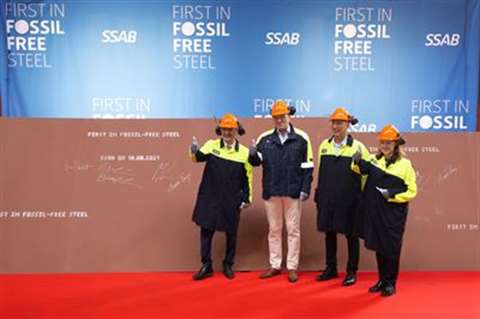 SSAB, LKAB and Vattenfall representatives showcase the world’s first hydrogen reduced sponge iron at HYBRIT’s pilot plant. Photo: SSAB
SSAB, LKAB and Vattenfall representatives showcase the world’s first hydrogen reduced sponge iron at HYBRIT’s pilot plant. Photo: SSAB
Instead, SteelZero has set out three broad ways in which its members can reach their interim targets. The first of these is to buy some of their requirement from mills certified by steel industry organisation Responsible Steel which audits mills according to a wide variety of strict environmental and employment standards. A second route is by acquiring steel from steel mills where the owner regularly publishes emissions data and has published a science-based target for reducing emissions. And a third route includes measuring the greenhouse gas intensity of the steel produced.
“In terms of delivery, it’s very early on,” says Peirce. “The first Responsible Steel sites are just coming on board now. The important thing is the framing of the commitment because it helps steel companies to think about how to implement these plans and what that would mean for their cycle investment.”
Ultimately, the group says it wants to get to a position where the steel its members are buying produces as close as possible to zero greenhouse gas emissions and any remaining emissions have been offset.
And, over the next two years, alongside technical partners, it plans to start tracking and reporting how much of each type of steel each company has bought as a proportion of its total procurement.
Tracking and reporting
“I think there is more complexity to come over how that is analysed so that we can do that in a way that isn’t burdensome, but at the simplest level it will be stating progress towards those 2030 and 2050 goals,” says Peirce. “We need to be able to track what they are buying because I think that will build confidence over exactly where the steel has come from and the nature of the net-zero-ness of it.”
The group is also attempting to work alongside the Clean Energy ministerial Industrial Deep Carbonisation Initiative (IDDI), an affiliation of public sector procurement bodies which have formed their own separate initiative to stimulate demand for low carbon industrial materials.
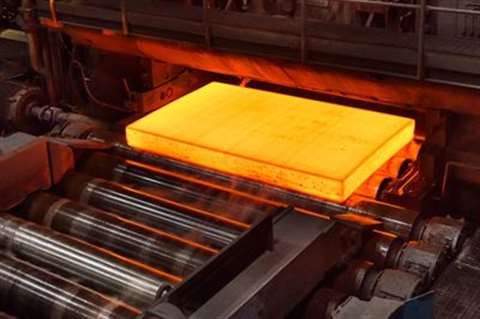 SSAB’s fossil-free steel. Photo: SSAB
SSAB’s fossil-free steel. Photo: SSAB
Peirce agrees that the group has a long way to go before it can even begin to make a difference. SteelZero’s current membership is heavily biased in favour of the UK and Europe, while the lion’s share of steel manufacture takes place elsewhere in China, the USA, India and South Korea. The group has recently been given funding to support an Indian chapter and is keen to start to expand further.
“The bigger next step is to say, how do we involve the US and in China? We know that’s going to be an evolution. We’ll know this has succeeded in X years’ time when we have brought on a much more internationally diverse membership to SteelZero.”
However, the point of the group is not necessarily to be representative of all steelmakers around the world – at least not yet – but to provide an example.
“As a model of change, we know it is important is to be able to get a first group that is willing to be vocal and take a leadership position. Then it becomes much more possible to engage in other markets,” says Peirce. “I don’t want to make it sound as though we will only have achieved success when every single company has joined the initiative because this sort of initiative aims to shift wider behaviour. If more people start doing it who are not members of SteelZero and more steel companies start changing faster than would have happened otherwise then we will still have been successful.”
Reducing direct emissions
In October, British Steel specifically mentioned SteelZero’s influence when it announced that it would be adopting science-based targets to reduce its direct emissions by 89%, reduce emissions from its purchased electricity by 3% and all other indirect emissions by 8%.
“Many of our customers require us to have climate change targets and be working to reduce our CO2 intensity,” said British Steel Chairman Huiming Li in a press release. “Internal analysis shows that the best path for British Steel to meet one of these [SteelZero] requirements is by adopting a science-based target.”
In fact, SteelZero members are already looking at ways of sourcing and incorporating low carbon steel into projects.
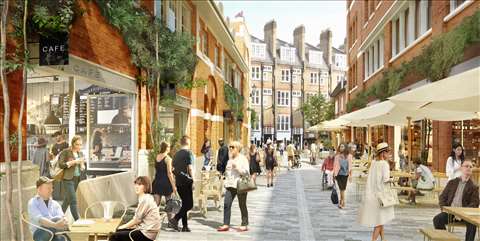 Grosvenor is looking to find ways to procure low carbon steel at its South Molton Triangle project in London’s Mayfair. Photo: Grosvenor
Grosvenor is looking to find ways to procure low carbon steel at its South Molton Triangle project in London’s Mayfair. Photo: Grosvenor
Property developer Grosvenor has been working with engineering firms Bourne Group and steel fabrication company William Hare as well as steel maker ArcelorMittal to work out ways in which it can source low embodied carbon steel to use in its South Moulton Triangle project in Mayfair, London which is due to start construction later this year.
“While there is a waiting time for net zero steel to become available, our members are not just pledging to cut carbon emissions in future, they are already engaging very actively in how they can bring in lower carbon steel to their projects, “says Peirce.
“For Grosvenor, early engagement with suppliers allows them to manage risk and opportunity, as incorporating change at the construction stage would prove costly and cause disruption. With our guidance, they’re working across the supply chain to address barriers to using net zero and low carbon steel.”
Moreover, by bringing buyers together Peirce says that members will also be able to act together as a lobby group attempting to make more low carbon and zero carbon steel available. Although the group has yet to meet to discuss this area in detail, SteelZero members are likely to have views about steel tariffs and other adjustment mechanisms.
But, says Peirce, the group’s first challenge is simply to stimulate supply.
“At the moment there isn’t the supply, so the first step is to get that moving,” he says. “There will be challenges in the next five or ten years about how you do that, where that works, which technologies are working that will really inform how the companies who have become members of SteelZero want to exercise their influence and their voice. In some ways that’s the exciting part. They can work together to say yes we do need to act together on policy either internationally or in a particular geography to be able to get the steel we want at a sensible price.”
Carbon plays three important roles in the traditional steel-making process: It can help turn mined iron ore into pig iron, process iron into steel, and it’s also a fuel that can help power these processes.
Most steel around the world is produced from rocks of iron ore. In the majority of steel making plants, iron is extracted from iron ore in a blast furnace. The furnace heats coking coal to around 1,100 degrees centigrade to produce coke and carbon monoxide. This reacts with the heated ore and oxygen to form pig iron and carbon dioxide. This process is called reducing. In the second part of the process, the pig iron is converted to steel by heating it again to remove more of the carbon, this time usually in a basic oxygen furnace.
High steel prices mean that there is also a strong market for recycling steel from scrap. In this process, the scrap steel is melted and processed using an electric arc furnace. However, electric arc furnaces also use vast amounts of power which in many countries still comes from coal-fired power stations. Moreover, high demand for steel means that there is unlikely to be enough recycled steel to supply all the new steel that is needed.
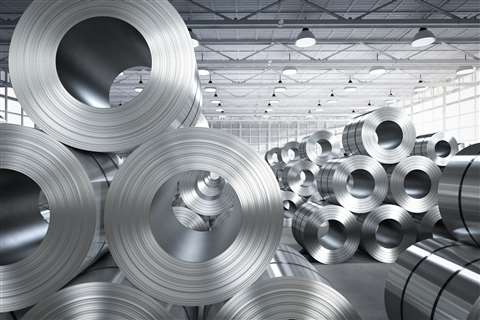 Rolls of sheet steel. Photo: Adobe Stock
Rolls of sheet steel. Photo: Adobe Stock
A few steel makers produce steel through a process called ‘direct reduction’ where, rather than using coking coal and a blast furnace to reduce iron ore, they use methane instead to reduce the ore. So far, the only carbon-free steel to be commercially produced has been made by directly reducing iron ore using hydrogen generated by renewable energy and then processing that in an electric arc furnace which has also been powered by green electricity. Another method which could be used to produce low carbon steel would be to continue to use coal powered blast furnaces with some form of carbon capture mechanism which would allow steel makers to then use or store the CO2 emitted during the process. Carbon capture is already used in some industrial processes such as ammonia production. However, it is much harder to do in the steelmaking process because CO2 mixes with other gasses. Alternatively, some work has been done on using direct electrolysis to turn iron ore directly into steel using electricity.
STAY CONNECTED



Receive the information you need when you need it through our world-leading magazines, newsletters and daily briefings.
CONNECT WITH THE TEAM








